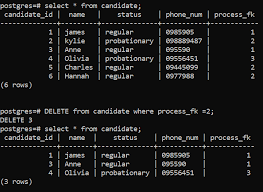PostgreSQL Create View - Shikshaglobe

PostgreSQL Create View
The CREATE VIEW statement in PostgreSQL allows you to define
a virtual table based on the result of a query. Unlike regular tables, views do
not store data physically; instead, they provide a dynamic representation of
the underlying data. By creating views, you can simplify complex queries,
abstract data structures, and enhance the overall efficiency of your database
operations. A view is a logical table based on the result set of an SQL
statement. A view contains no data itself. The fields in a view are fields from
one or more real tables in the database. You can add SQL functions to a view,
and the view can be used to insert, update or delete data in the real tables.
Views are typically used to simplify the complexities of real tables or to
restrict access to data in the underlying tables.
Views are a way to logically group data in a database. A
view consists of a query that is stored in the database. When you execute the
query, the results are displayed as if you had run the query directly on the
underlying tables. You can use views to answer specific questions about your
data or to generate reports. You can also use views to restrict access to
sensitive data by creating a view that only displays the data that you want
people to see.
Views are a way to logically group columns and rows from one
or more tables into a single virtual table. A view contains no data itself but
gets its data "pushed" from the tables that it references when it is
queried. Creating a view is therefore very similar to creating a table: CREATE
VIEW myview AS SELECT column1, column2 FROM mytable; Views can be created from
multiple tables: CREATE VIEW myview AS SELECT column1, column2 FROM mytable1
JOIN mytable2 ON (mytable1.column1 = mytable2.column1);Views are a virtual
table based on the result-set of an SQL statement.
A view contains no data itself, but is like a window through
which data from tables can be seen or changed. Creating a view requires the
CREATE VIEW privilege. A user who only has the SELECT privilege for some
columns of a table cannot create a view that exposes other columns unless the
owner of the table (or a superuser) grants him the necessary privileges.
2. Syntax and Usage
The syntax for creating a view in PostgreSQL using the
CREATE VIEW statement is as follows:
CREATE VIEW view_name AS
SELECT column1, column2, ...
FROM table_name
WHERE condition;
Here, view_name refers to the name you want
to assign to the view, column1, column2, ... represents the
columns you want to include in the view, table_name is the
source table from which the view is created, and condition specifies
any filtering or joining criteria.
3. Creating Views with SELECT Statements
The CREATE VIEW statement in PostgreSQL allows you to create
views by defining a SELECT statement as the source of the view. You can specify
the columns you want to include, apply filtering conditions, perform joins with
other tables, and even aggregate data within the view. This flexibility enables
you to tailor the view's structure to your specific needs.
4. Modifying Views
Once you have created a view, you can modify it using the
ALTER VIEW statement. PostgreSQL allows you to add or drop columns, change the
view's definition, or rename the view itself. This capability empowers you to
adapt your views as your data requirements evolve.
5. Utilizing Views for Data Abstraction
Views offer a powerful mechanism for data abstraction. By
creating views that encapsulate complex queries or data transformations, you
can provide a simplified and focused interface for data retrieval and analysis.
Views can hide the underlying complexity of your database structure and present
a more intuitive representation of the data.
6. Security and Privileges for Views
PostgreSQL allows you to control access to views using the
same security and privilege mechanisms applied to regular tables. By granting
appropriate permissions, you can restrict or grant access to specific views,
ensuring data confidentiality and maintaining proper data governance.
7. Performance Considerations
While views provide convenience and abstraction, it's
important to consider their impact on performance. Since views are based on
underlying queries, their performance is tied to the efficiency of those
queries. It's recommended to optimize the underlying queries and utilize
appropriate indexes to ensure optimal performance when querying views.
8. Best Practices for Using CREATE VIEW
To make the most of the PostgreSQL CREATE VIEW statement,
consider the following best practices:
- Keep
views concise and focused, addressing specific data retrieval or analysis
requirements.
- Use
meaningful and descriptive names for your views to enhance clarity and
maintainability.
- Regularly
review and optimize the underlying queries to ensure optimal performance.
- Document
and communicate the purpose and usage of your views to facilitate
collaboration among your team members.
9. Conclusion
PostgreSQL CREATE VIEW provides a powerful mechanism for
simplifying data retrieval and analysis. By creating views, you can abstract
complex queries, enhance data accessibility, and improve overall database
efficiency. Understanding the syntax, usage, and best practices of CREATE VIEW
empowers you to optimize your database workflows and make informed data-driven
decisions.
10. FAQs
Q1. Can I update data through a view in PostgreSQL? In
PostgreSQL, you can update data through a view under certain conditions. The
view must be updatable, meaning it must meet specific criteria such as having a
single table in the FROM clause and including all columns that do not have a
default value or are not defined as NOT NULL.
Q2. Can I create a view with joins across multiple
tables? Yes, you can create a view with joins across multiple tables.
By using appropriate JOIN statements in the underlying SELECT statement of the
view, you can combine data from multiple tables into a single virtual table.
Q3. Can I grant permissions on views in PostgreSQL? Yes,
you can grant permissions on views in PostgreSQL using the same GRANT statement
used for tables. This allows you to control access to specific views based on
user roles or privileges.
Q4. Are views materialized in PostgreSQL? PostgreSQL
provides the option to create materialized views, which store the result of the
view query physically. Unlike regular views, materialized views require manual
refreshing to update their data.
Q5. Can I use views in performance-critical scenarios? While views provide convenience and abstraction, their impact on performance depends on the underlying queries. Optimizing the queries and utilizing appropriate indexes can help ensure optimal performance when querying views.











